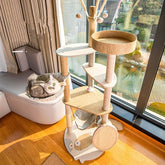Understanding Cat Emotional Burnout: Signs, Solutions, and Support Strategies
Table of Contents
- Key Highlights:
- Introduction
- Recognizing the Signs of Emotional Burnout in Cats
- Creating a Safe and Calming Home Environment
- Offering Gentle, Positive Interactions
- Enriching Your Cat’s Life with Stimulating Activities
- Addressing Underlying Health Issues
- Building Trust Through Routine and Predictability
- Knowing When to Seek Professional Help
Key Highlights:
- Cats can experience emotional burnout, manifesting through behavioral changes such as withdrawal, irritability, or loss of interest in activities.
- Creating a calming home environment, establishing routines, and offering gentle interactions can significantly aid in a cat's emotional recovery.
- If signs of burnout persist despite supportive measures, consulting a veterinarian or professional behaviorist is crucial for addressing underlying issues.
Introduction
Cats are often seen as resilient creatures, predominantly self-sufficient and independent. However, they, too, can suffer from emotional distress, particularly in the form of burnout. Emotional burnout in cats can rival the stress that humans experience, leading to profound behavioral shifts that can be perplexing for pet owners. Signs may include withdrawal from social interaction, changes in grooming habits, and alterations in appetite. These signs indicate a need for immediate attention and understanding. This article aims to elucidate the causes of emotional burnout in cats, recognize its symptoms, and outline actionable steps owners can take to support their feline companions back to mental wellness.
Recognizing the Signs of Emotional Burnout in Cats
Identifying emotional burnout can prove challenging due to the nuanced changes in a cat’s behavior. Owners must remain observant and attuned to subtle signals. Keep an eye out for the following signs:
- Increased Sleeping: While cats sleep a lot by nature, any drastic increase in sleep duration or a preference for seclusion can indicate emotional fatigue.
- Withdrawal: A formerly social cat may begin to hide in secluded spaces, avoiding interaction with family members or other pets. This retreat can often be mistaken for a typical behavior, but when it becomes pronounced, it's a warning signal.
- Changes in Play Behavior: Loss of interest in play is often one of the first changes noticed. If a playful kitten suddenly turns disinterested in toys, the shift may signal emotional distress.
- Grooming Changes: Many cats groom themselves regularly, and a noticeable decline in grooming habits can lead to an unkempt coat and possibly skin issues.
- Appetite Fluctuations: Changes in eating habits—either a decrease in appetite or, conversely, excessive eating—can also highlight an emotional issue. Monitoring eating behaviors can provide critical insights into a cat's emotional state.
- Aggression or Irritability: A typically friendly cat may display unexpected aggression or irritability. This can be especially concerning and often confuses owners who might misinterpret the shift as behavior issues.
Understanding these behaviors as indicators of emotional health is pivotal. Cats often rely on their owners to detect and address these signs, and remaining proactive in observing behavioral shifts is essential for timely intervention.
Creating a Safe and Calming Home Environment
A peaceful living space forms the bedrock of emotional recovery for a frazzled cat. Crafting an environment that promotes security and relaxation can alleviate stress significantly. Here are practical steps to achieve this:
1. Cozy Retreats
Designate quiet, soft spaces for your cat to escape the hustle and bustle. These areas can include:
- A soft bed tucked away in a quiet corner.
- A cardboard box lined with blankets to mimic a den-like feeling.
- Elevated spots by windows that allow for bird-watching or sunbathing.
2. Minimize Loud Noises
Cats are sensitive to noise, so reducing sudden sounds can help them maintain a calm demeanor. This involves:
- Using soft furnishings to reduce echoes in the home.
- Limiting exposure to loud appliances and sudden disturbances.
3. Consistent Routines
Cats thrive on routine. Adhering to regular feeding schedules, playtimes, and quiet moments can create a reliable atmosphere that alleviates anxiety. Predictability helps them feel secure in their environment.
4. Calming Aids
Incorporate calming tools like pheromone diffusers or sprays, which can provide reassurance for stressed pets. These products mimic feline pheromones, instilling a sense of comfort.
5. Respecting Boundaries
If interacting with other pets or children, be sure your cat has access to retreats away from potential overstimulation. Creating a safe space for recovery is crucial.
By establishing a serene home environment, cat owners can foster emotional recovery, setting the stage for healing and rejuvenation.
Offering Gentle, Positive Interactions
Encouraging positive bonding moments is vital when a cat is emotionally depleted. The manner of interaction should be gentle and at the cat’s pace. Here are effective approaches:
1. Slow Approach
When offering affection, approach slowly and let your cat decide if and when to engage. This allows your cat to exert control over their interactions, fostering trust.
2. Soft, Reassuring Communication
Use soothing tones to convey comfort. Sometimes, simply existing peacefully in the same space can communicate love without the pressure of forced affection.
3. Positive Reinforcement
Utilize treats and toys as incentives for amicable interactions. Celebrate small victories when your cat initiates contact, reinforcing the idea that engagement is a wonderful experience.
4. Honor Their Space
If your cat seems disinterested or prefers solitude, respect their need for space. Pushing for interaction can exacerbate feelings of burnout. Recognize that recovery is a gradual process, and be patient.
Enriching Your Cat’s Life with Stimulating Activities
A stimulated cat is less prone to emotional burnout. Implementing gentle enrichment strategies can rejuvenate your cat’s spirits. Here are some suggestions:
1. Rotating Toys
Keeping toys fresh by rotating them can spark curiosity and prevent boredom. Introduce interactive toys or simple implements availing for their hunting instincts, like feather wands or laser pointers.
2. Puzzle Feeders
Introduce puzzle feeders that require cats to work for their food. This reinforces natural hunting behavior while keeping their minds engaged.
3. Window Perches
Set up a perch by a window for bird-watching, where your feline can enjoy the sights of the outside world. This can mentally stimulate them and lift their mood.
4. Safe Outdoor Experiences
If feasible, create a safe catio for outdoor exploration. Outdoor spaces provide an array of stimuli and experiences that enrich their life and combat boredom.
5. Simple Play Objects
Even simple items—a cardboard box or crinkly paper—can become a source of joy and engagement. Utilize everyday objects that encourage exploration without overwhelming your cat.
Maintaining a variety of stimulating activities ensures your cat remains mentally engaged, providing them avenues to rediscover joy and playfulness.
Addressing Underlying Health Issues
It’s crucial to recognize that emotional burnout can sometimes be intertwined with physical health concerns. Cats often mask pain and discomfort, which can make it challenging for owners to identify underlying issues. Here’s how to ensure your feline friend stays healthy:
1. Regular Veterinary Check-ups
Always consult a veterinarian regarding any noticeable behavior changes. Conditions such as chronic pain, infections, or thyroid issues may masquerade as emotional problems.
2. Behavior Discussions
Discuss any shifts in behavior, appetite, or grooming with your vet. This information can provide context that is vital for diagnosis and treatment.
3. Medication Management
If your cat is on medications, ensure dosages are accurate and evaluate for any side effects that could influence their emotional health.
4. Diet Tweaks
If necessary, adjust their diet or consider supplements recommended by your veterinarian. Good nutrition supports both physical and mental well-being.
By addressing health concerns directly, you establish a foundation for emotional recovery, allowing your cat to thrive physically and mentally.
Building Trust Through Routine and Predictability
Cats are creatures of habit. Establishing a routine not only comforts them but also helps in building a strong bond of trust. Here’s how to implement this effectively:
1. Consistent Daily Routines
Set a structured daily routine for meals, play, and rest. Consistency alleviates anxiety and signals safety, helping your cat feel secure in their surroundings.
2. Gradual Introductions
If changes are unavoidable, introduce them slowly to avoid overwhelming your cat. For instance, if a new pet joins the household, allow for gradual introductions, maintaining the established routines.
3. Comforting Rituals
Small rituals, such as a nightly treat or a gentle brushing, can become comforting habits. These moments help reinforce your presence as a source of comfort and security.
4. Reassurance During Changes
Whenever introducing new elements, accompany them with positive reinforcement and extra assurances. A trusted environment promotes emotional healing.
By providing structure, cats learn that they can rely on their environment, establishing a stable atmosphere conducive to emotional recovery and trust-building.
Knowing When to Seek Professional Help
In certain situations, despite your robust efforts to support your cat, emotional burnout may persist or worsen. Understanding when to seek professional assistance is key.
1. Recognizing Serious Signs
If your cat continues to show signs of withdrawal, aggression, or self-harm, it's imperative to consult a professional—such behaviors can indicate deeper issues requiring expert intervention.
2. Consulting Behaviorists
Feline behaviorists can provide specialized behavior modification plans tailored to your cat’s needs, addressing emotional health through a focused approach.
3. Veterinarian Collaboration
Your veterinarian may suggest therapeutic tools or consider medications to support recovery if necessary. Exploring all options in consultation can enhance your cat’s well-being.
4. Embracing Support
Never hesitate to seek help; it’s vital to remember that pursuing professional advice is neither a sign of failure nor a lack of commitment—it illustrates a responsible effort for your cat’s comfort and happiness.
FAQ
What are the primary causes of emotional burnout in cats?
Emotional burnout in cats can stem from various factors, including sudden changes in environment, loss of a companion, lack of stimulation, or chronic stress due to overpopulation or conflicts with other pets.
How can I tell if my cat is unhappy?
Signs may include increased withdrawal, changes in grooming, alterations in eating habits, aggression, and lethargy. Monitoring behavior closely will help you identify any troubling signs.
Should I force my cat to engage when they are withdrawn?
No, it’s imperative to let your cat set the pace. Forcing interaction can lead to further withdrawal or anxiety. Gentle, patient approaches are best.
When should I consult a veterinarian regarding my cat's behavior?
If behavioral changes persist or escalate, particularly involving aggression or self-harm, it is crucial to consult a veterinarian. Underlying medical issues may need to be ruled out.
Can environmental changes impact my cat's behavior?
Absolutely. Cats are sensitive to changes in their environment. Sudden fluctuations in routine, noises, or new animals can stress them, potentially leading to emotional burnout.
By employing these insights and strategies, cat owners can play a significant role in their pets' emotional wellness, ensuring a happy and fulfilled feline experience.





